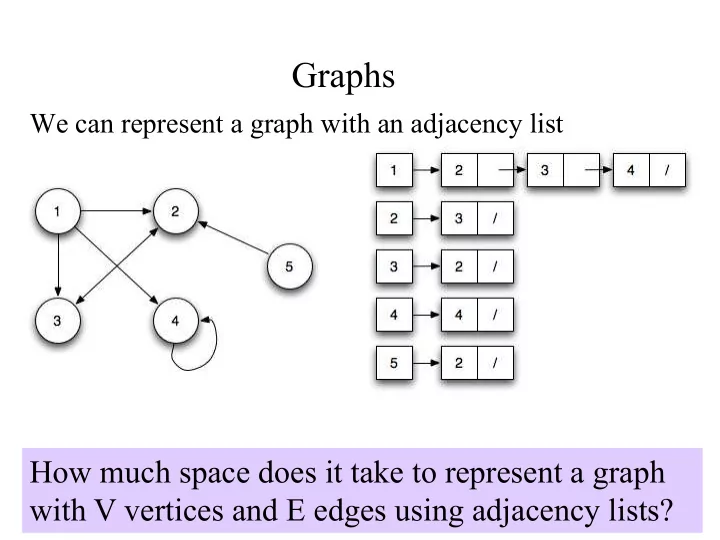

Graphs We can represent a graph with an adjacency list How much space does it take to represent a graph with V vertices and E edges using adjacency lists?
Graphs We can represent a graph with an adjacency matrix How much space does it take to represent a graph with V vertices and E edges using adjacency matrix?
Graphs We can represent a graph with an adjacency list How much time does it take to add an edge (u,v) to a graph with V vertices and E edges using an adjacency list representation?
Graphs We can represent a graph with an adjacency matrix How much time does it take to add an edge (u,v) to a graph with V vertices and E edges using an adjacency matrix representation?
Graphs We can represent a graph with an adjacency list How much time to determine if there is an edge (u,v) in a graph with V vertices and E edges using an adjacency list, assuming that the degree of u is k?
Graphs We can represent a graph with an adjacency matrix How much time to determine if there is an edge (u,v) in a graph with V vertices and E edges using an adjacency matrix, assuming that the degree of u is k?
Graph Traversals Tricolor algorithm: White nodes are undiscovered nodes that have not been seen yet in the current traversal and may even be unreachable. Black nodes are nodes that are reachable and that the algorithm is done with. Gray nodes are nodes that have been discovered but that the algorithm is not done with yet. These nodes are on a frontier between white and black. The algorithm pseudo-code is as follows: Color all nodes white, except for the root nodes, which are colored gray. While some gray node n exists: color some white successors of n gray. if n has no white successors, optionally color n black. What different ways can we choose gray node n?
Depth First Search DFS(Vertex v) { set color of v to gray for each successor v' of v { if v' not yet visited { DFS(v') } } set color of v to black } Trace through the algorithm with this graph marking vertices gray and black. What order do they become gray? What order do they become black?
DFS DFS(Vertex v) { set color of v to gray for each successor v' of v { if v' not yet visited { DFS(v') } } set color of v to black } How many calls to DFS are made by the algorithm if we have V vertices and E edges?
DFS DFS(Vertex v) { set color of v to gray for each successor v' of v { if v' not yet visited { DFS(v') } } set color of v to black } What is the total number of times the for loop will be iterated in the algorithm if we have V vertices and E edges?
DFS DFS(Vertex v) { set color of v to gray for each successor v' of v { if v' not yet visited { DFS(v') } } set color of v to black } What is the order of growth for the time if we have V vertices and E edges?
Connected Components How can we use DFS to determine the number of connected components in a graph? Write the algorithm
Topological Sort Give some ordering of these 7 steps that make sense.
Topological Sort Perform a DFS on this graph and note the order in which nodes get marked black. What is your order?
Topological Sort How can we use DFS to give a topological ordering? Write the algorithm
DFS – Edge Classification Tree Edge: Destination node is white Back Edge: Destination node is gray Forward/Cross: Destination is black Cross if goes from one tree to another What do we know about a directed graph with no back edges?
Detect Cycles Tree Edge: Destination node is white Back Edge: Destination node is gray Forward/Cross: Destination is black Cross if goes from one tree to another How can we use DFS to determine if there is a cycle? Write the algorithm
Breadth First Search BFS(Vertex root) { Trace through the frontier = new Queue() algorithm with this graph mark root as gray marking vertices gray and frontier.enqueue(root) black. while frontier not empty { What order do they Vertex v = frontier.dequeue() for each successor v' of v { become gray? What order if v' white { do they become black? frontier.enqueue(v') mark v' gray } } mark v as black } }
Breadth First Search BFS(Vertex root) { How can we use BFS to frontier = new Queue() find the shortest path (least mark root as gray number of edges) from a frontier.enqueue(root) given vertex to a second while frontier not empty { vertex? Vertex v = frontier.dequeue() for each successor v' of v { if v' white { frontier.enqueue(v') mark v' gray } } mark v as black } }
Recommend
More recommend